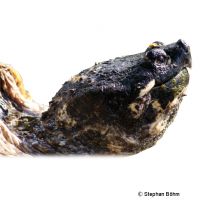Common Snapping Turtle (Chelydra serpentina)
| Common Snapping Turtle Chelydra serpentina | |
|---|---|
| Name | Common Snapping Turtle |
| Name Lat. | Chelydra serpentina |
| Family | Snapping Turtles |
| Family lat. | Chelydridae |
| Order | Turtles |
| Order lat. | Testudines |
| Origin | North America |
| Habitat | Rivers, estuaries |
| Diet | Fish, small mammals |
| Humidity | 60-80 % |
| Behavior | Aggressive |
| Keeping | Individual, pair |
| Care Level | Experts only |
| Reproduction | Oviparous |
| Housing | Aquaterrarium |
| Life Span | 25-30 years |
| Protection | CITES Appendix III; EU Annex C |
| Metric Units | |
| Size | 40 cm |
| Temperature | 25-30 °C |
| Temperature Local | 35-40 °C |
| Housing Size | 200 x 80 x 80 cm |
| US Units | |
| Size | 16" |
| Temperature | 77-86 °F |
| Temperature Local | 95-104 °F |
| Housing Size | 80" x 30" x 30" |
Distribution and habitat
The distribution area of the little mobile snapping turtle extends from southeastern Canada to Mexico, Guatemala and Honduras. There it inhabits the shallow, marshy and densely vegetated banks of rivers and their estuaries (brackish water).
Maintenance
Minimum dimensions for the aquaterrarium, according to the size and number of animals
| floor space for 1-2 animals: 3PL x 1,5PL (L x W) | Water level: 2PB |
The carapace length (PL) and carapace width (PB) is measured on the largest animal. For each additional animal, increase the footprint by 10%, and for the 5th animal and larger, increase the footprint by 20%. An aquaterrarium of e.g. L 200 x W 80 x H 80 cm is recommended, which should be placed in a quiet and vibration-free place
The incompatible and biting snapping turtle needs a spacious, unplanted aquaterrarium with large, branched roots, stable stone structures (hiding places) as well as a fine gravel substrate of double shell height, as the animals like to burrow in for camouflage. The water may be at most so deep that the animals can reach the water surface by lifting their heads. A powerful filter and frequent water changes are recommended to maintain water quality. The terrestrial part should be equipped with roots and foliage for hiding, shaded areas and a small dry sandy area for basking.
| Water Temp | lighting | Sunny | |
| Summer | 20-28 °C | 12-14 hrs. | 35-40 °C |
| Winter (2-3 months) | 4-10 °C | 6-8 hrs |
They need high light intensity and daily UV irradiation as well as sunny places with radiant heat.
Diet
The diet consists of fish, fish fillets, worms, mice and meat of all kinds, supplemented with pelleted ready-made food. Young animals should be offered food daily, adult animals twice a week. Regular addition of minerals and vitamins is important
A varied diet promotes health and prevents deficiency symptoms.
Reproduction and breeding
Males have a concave ventral carapace and a much longer tail than females. The anal opening of the male is closer to the tip of the tail than in the female.
A small, sandy land area is necessary for egg laying. There the eggs are buried about 20 cm deep. At a temperature of 20-25 °C the incubation period is 80-89 days.
The life expectancy can be 25-30 years.
Species protection
According to § 3 of the Bundesartenschutzverordnung (BArtSchV) it is forbidden for private persons to offer these animals, to keep them in stock for sale, to keep them for sale or to sell them to others or to breed them!
Protection of species: WA appendix III; EU appendix C. Export permit required for animals from the USA.
Important
Due to the long neck they can fling their head far over the back and bite, therefore only touch from behind. Be careful, bites can cause serious injuries! They are suitable for year-round outdoor residence. Subspecies from southern distribution areas must not be kept below 10 °C water temperature in winter
In order not to distort the native fauna, snapping turtles must not be released into the wild under any circumstances.
The terrarium must have good ventilation without drafts and meet the species-specific needs. Measuring devices such as thermometers, hygrometers, etc. are necessary. The lighting has to correspond to the species-specific day-night rhythm and has to be placed in such a way that the animals cannot injure themselves. The terrarium should be locked in such a way that neither unauthorized persons can open it nor the animals can escape. Contamination must be removed regularly
Further literature can be found in your pet store.
References
Text: Christian Sänger; Image: Stephan Böhm
Source: BMELV (1997): Mindestanforderungen an die Haltung von Reptilien; ENGELMANN (2006): Zootierhaltung - Tiere in menschlicher Obhut: Reptilien und Amphibien, Harri Deutsch Verlag
- Gemäß § 21 Abs. 5 Tierschutzgesetz idgF
